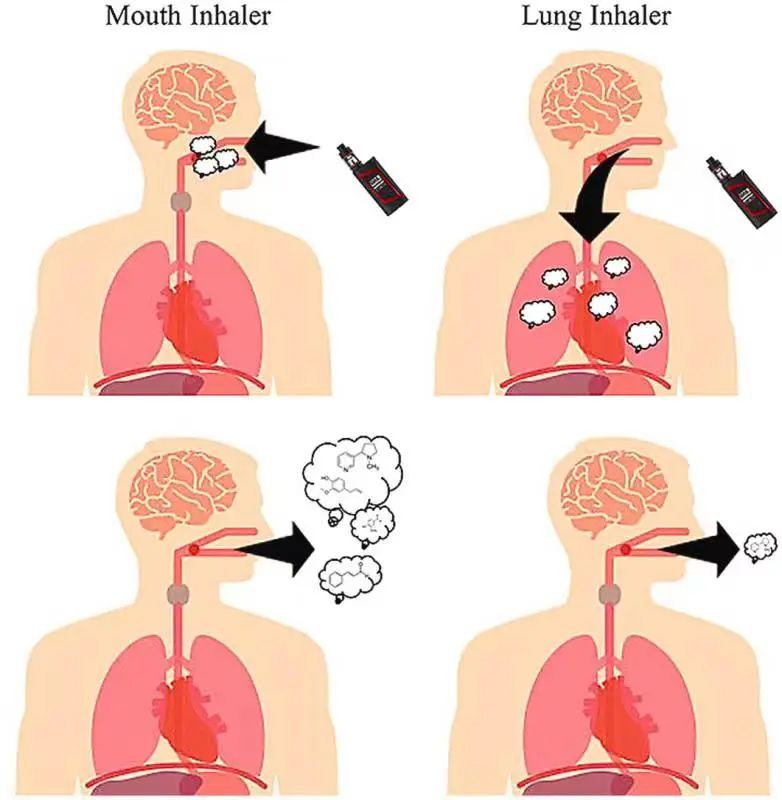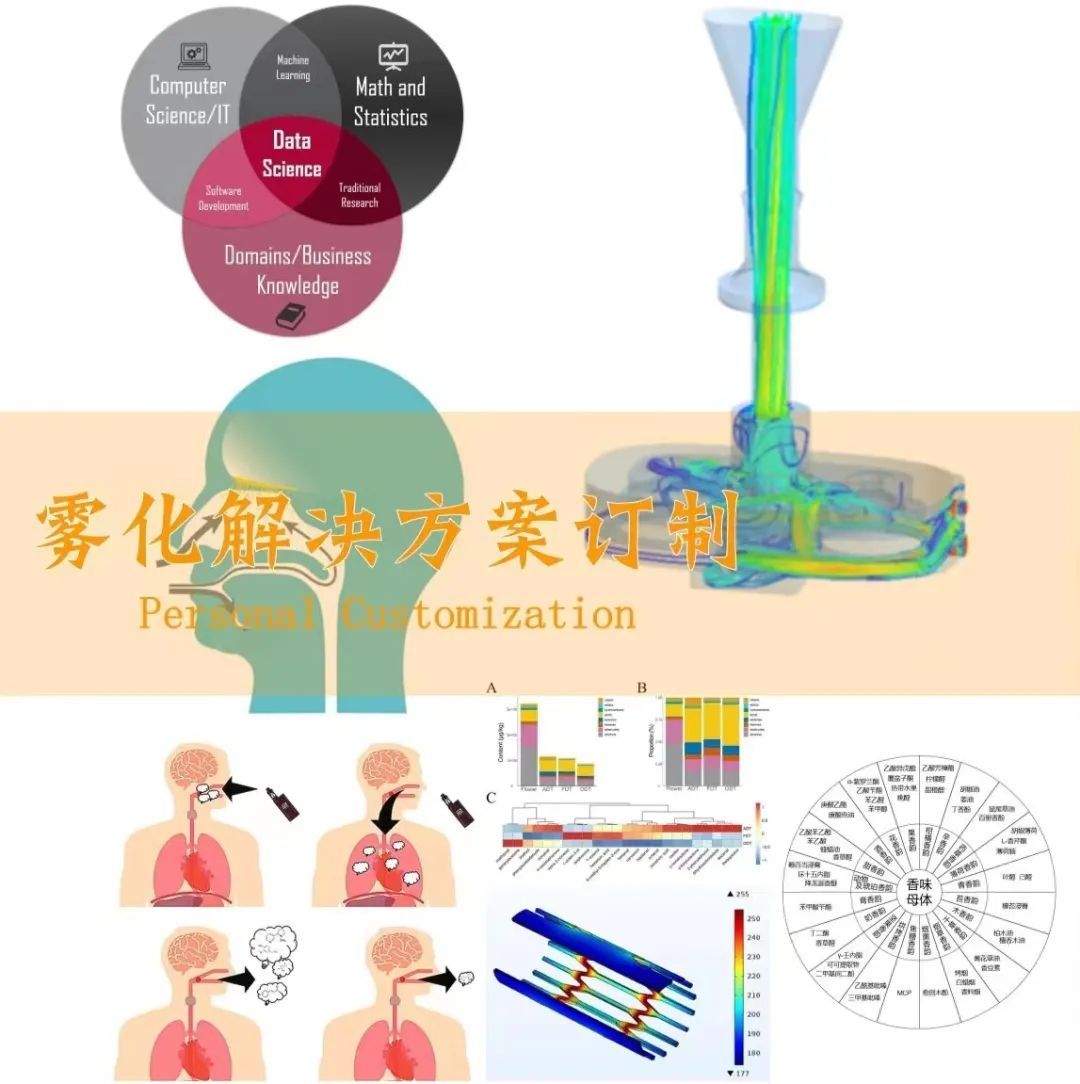Secrets of Electronic Cigarette Flavor: The Aerosol Chapter (Part Three): Movement, Deposition Characteristics of Aerosols and Sensory Experience
This article presents the movement and deposition characteristics of electronic cigarette aerosols in the respiratory tract and their impact on sensory experiences. Aerosols can provide sensory experiences such as aroma, taste, coolness, and irritation. The movement and deposition of aerosols are influenced by the method of inhalation; the "small cycle" inhalation method causes aerosols to primarily remain in the oral cavity, while the "large cycle" method leads aerosols through the entire respiratory system. Different inhalation methods result in different sensory experiences. Understanding these characteristics helps in better sensory evaluation and product improvement.
上一期我们了解了气溶胶的基本参数及运动沉积特点,本期我们将介绍气溶胶在呼吸道中的运动、沉积特点与感官体验的相关内容。
Topic 3 气溶胶运动、沉积特点与感官体验
(1)气溶胶能带来哪些感官体验?
① 香气。电子烟感官评价指南(二):气味感知与嗅觉疲劳介绍了我们在抽吸时如何利用嗅觉感受气溶胶中的香气,感兴趣的小伙伴请点击前往。
② 味道。我们口腔中的味蕾接收刺激,并进一步形成味道感知。味蕾主要集中于舌部,也存在于口腔壁、喉咙等口腔内部表面。目前较为公认的5种基本味道为甜、酸、苦、咸、鲜。
③ 凉感。气溶胶中的凉味剂并不实际降低我们呼吸道中的温度,而是直接触发温度感受器,进而产生凉感。除了口腔和鼻腔外,我们的喉部及部分呼吸道也能够产生凉感。
④ 刺激感。此处主要指“击喉感”,由尼古丁(或尼古丁盐)刺激呼吸道和喉咙的黏膜而产生。通常被描述为一种刺激。
⑤ 视觉、听觉(气溶胶产生时雾化器发出的声音)等。不在本系列展开讨论。
(2)气溶胶在呼吸道中运动和沉积
上期文章介绍了气溶胶在呼吸道中沉积的粒径分布情况。本期将抛开具体的粒径数值,从整体的角度分析气溶胶带我们的感官体验。因此,本文中粒径较大的气溶胶称为大颗粒,粒径较小的气溶胶称作小颗粒,大和小是相对的概念。
如图1,左侧上下两张图分别表示局部循环(小循环)抽吸方式下的气溶胶吸入和呼出过程;右侧的上下两张图分别表示整体循环(大循环)抽吸方式下的气溶胶吸入和呼出过程。

图1 气溶胶吸入、呼出示意图
(图源:https://doi.org/10.1016/j.chemosphere.2021.131494)
我们可以看到,使用小循环进行抽吸时,气溶胶仅经过了口腔(伴随少部分上呼吸道区域);使用大循环进行抽吸时,气溶胶则经过了完整的呼吸系统。
(3)气溶胶的运动、沉积如何影响感官体验
① 香气。
使用小循环吸入时,大颗粒与小颗粒全部短暂停留于口腔,随后经过鼻腔呼出。绝大多数的气溶胶都会经过嗅觉感受器,鼻腔将感受到非常浓烈的香气。使用大循环吸入时,部分大颗粒沉积在口腔中,其余气溶胶经过呼吸道,逐级递减后到达肺部,随后肺部收缩挤出呼吸道中的气溶胶,经鼻腔呼出。由于气溶胶在呼吸道各处都会有不同程度的沉积,同等吸入量的情况下,鼻腔感受到的香气将弱于小循环。
② 味道。
使用小循环吸入时,由于气溶胶驻留在口中的时间长,舌部对甜味、酸味的感知会更加明显,同样对于苦味的感知也会更加明显。因此,在判断气溶胶“是否发苦”时,这种抽吸方式会更敏感。使用大循环吸入时,部分小颗粒通过呼吸道进入喉部以及肺部,舌部和口腔接触到的气溶胶量减少,因此对味道的感知将弱于小循环。此外,“鲜味”是否能够通过电子烟气溶胶的方式感受到,也是非常值得期待的。
③ 凉感。
使用小循环吸入时,只有鼻腔和口腔会产生凉感; 使用大循环吸入时,我们的口腔、鼻腔、喉部和部分呼吸道都能被气溶胶携带的凉味剂激活温度受体,进而产生凉感,因此大循环能够很好地从整体的角度评价气溶胶的凉度。
④ 刺激感。
使用小循环吸入时,无法感受到喉部主导的刺激感;使用大循环吸入时,大颗粒和小颗粒均会大量经过喉部及附近的呼吸道,产生“击喉感”,这种感觉让电子烟用户更享受吸烟的乐趣,进而增加对尼古丁摄入的依赖(https://doi.org/10.1007/s00213-005-0250-x)。
不同的抽吸方式决定了气溶胶的运动路径,不同的运动路径决定了不同的感官体验。了解气溶胶的运动路径和沉积特点,将帮助我们更好地进行感官评价和产品改进、升级。此外,当遇到特定问题的时候(例如甜感评价时、凉感评价时),能够选择相应的抽吸方式,从而更加准确地获得感官信息。
本期与大家一起了解了气溶胶运动、沉积特点与感官体验的相关内容,欢迎后台留言解锁下期话题!
原创产品,制作不易,转载请注明出处。感谢各位的订阅和支持!
越多点赞,越多订阅,越多优质内容~~ 欢迎催更!!

原文始发于微信公众号(雾化探秘):Secrets of Electronic Cigarette Flavor: The Aerosol Chapter (Part Three): Movement, Deposition Characteristics of Aerosols and Sensory Experience
电子雾化与HNB产品都是新型电子产品,结构虽小,却融合应用多种材料、表面处理、芯片电子等技术工艺,而且雾化技术一直在不断更迭,供应链在逐步完善,为了促进供应链企业间有一个良好的对接交流,艾邦搭建产业微信群交流平台,欢迎加入;Vape e-cigarettes (VAPE) and Heat-Not-Burn e-cigarettes (HNB) are both emerging electronic products. Despite their compact size, they integrate various materials, surface treatment technologies, chip electronics, and other advanced technical processes. Moreover, atomization technology is constantly evolving and the supply chain is being progressively perfected. To facilitate good communication and networking among supply chain enterprises, Aibang has established an industry WeChat group communication platform and warmly welcomes interested enterprises to join.

